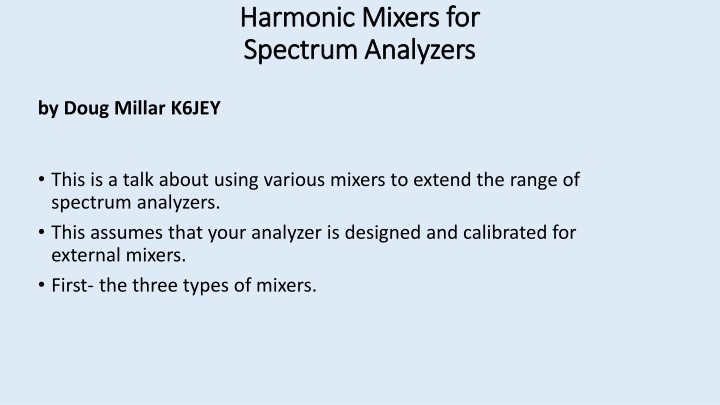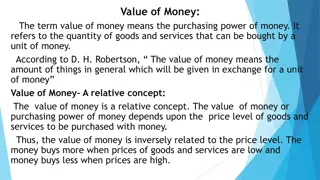Indian Money Market Regulatory Framework
This content delves into the regulatory framework of the Indian money market, highlighting the role of key entities like the Reserve Bank of India and FIMMDA. It covers the objectives, scope, and activities of FIMMDA in developing and promoting the bond, money, and derivative markets in India.
Download Presentation

Please find below an Image/Link to download the presentation.
The content on the website is provided AS IS for your information and personal use only. It may not be sold, licensed, or shared on other websites without obtaining consent from the author.If you encounter any issues during the download, it is possible that the publisher has removed the file from their server.
You are allowed to download the files provided on this website for personal or commercial use, subject to the condition that they are used lawfully. All files are the property of their respective owners.
The content on the website is provided AS IS for your information and personal use only. It may not be sold, licensed, or shared on other websites without obtaining consent from the author.
E N D
Presentation Transcript
Harmonic Mixers for Harmonic Mixers for Spectrum Analyzers Spectrum Analyzers by Doug Millar K6JEY This is a talk about using various mixers to extend the range of spectrum analyzers. This assumes that your analyzer is designed and calibrated for external mixers. First- the three types of mixers.
Tektronix Mixers There are two main series of mixers with some going to 300GHz The WM490 and WM780. The 490 has no calibration and the 780 has a built in chart. The suffix of either tells you which band they are designed for. The mixers have a load at the far end and a stepped waveguide to the diode. The diode is a point contact type and will only take 32mw. It is also sensitive to impact.
The complete Set of WM490 mixers And horns. 5-20K bucks
WM780 The Cal Chart is on the other side.
More Details on Tek Mixers All of the Tek mixers are two port- an input and IF. To work with some analyzers they have to have a diplexer to combine the IF input and the LO output to the mixer. It is possible that the only difference in mixers is their waveguide and TEK uses the same diode in all of them. However, since the diode whisker is hand placed, each mixer could be quite different. Conversion loss is about 25-35db.
HP Mixers Three port types that don t need a diplexer. They use diodes on a substrate and are quite physically robust The do use the same diode in all the mixers Cables loss in all the mixers is important The IF of the HP mixers is about 310MHz. They will also take 200mw.
HP 11970 Series Mixer HP 11970 Series Mixer Cal Chart WG Input IF and LO Ports
Miscellaneous Mixers SDMS FXR Phillips Hughes? WR 42 Systron Donner Duplexer Spacek WR 10 with horn
Inside the Phillips Phillips Mixer Originally designed for 40GHz with a tapered feed and a great diode. It works well on Tek and HP analyzers It works well up through 120GHz! Not bad for $50 or less. Outside
Waveguide Limitations According to the books A waveguide s lower limit is 20% of the lower rated frequency. WR28 can go down to 26GHz with a sudden drop off. A waveguide s upper limit is twice the max rated frequency. WR28 can go up to 80GHz with a gentle rise in loss. From the curves below, mixers do much better above their designed frequency. A mixer with WR22 looks like the best compromise.
What Happens in the Real World? The following is data taken from an HP 8563 and compared to a Tek 494AP.
Test Data Based on using an HP 8563A analyzer and Tek duplexer as needed. Mixer -dbm at 79GHz Rank -dbm at 119GHz Rank WM780W (75-115GHz) -44 5 -66 6 WM490U (40-60GHz) -36 4 -57 3 Phillips -33 3 -55 WR28 horn +10db 4 HP 11970Q (33-50GHz) -24 1 -63 5 Spacek WR 10 -28 2 -58 1 FXR (WR12) -57 7 -75 7 Cube (35GHz) -45 6 -58 2 Conclusions- The Phillips box comes out on top for price/value The HP works nicely out of its range. Second best value. The WM780 did not do well, but it is calibrated. The FXR is an older type. Most don t do well. All of the mixers give an adequate S/N for adjusting rigs.
Observations about buying mixers You can find all sorts of mixers for lots of different prices. Do they work? Beware of cheap ones and do not assume that an expensive is very good. You will pay a premium for higher frequencies. It is better to make a lower frequency item to work at higher frequencies. Do not confuse a detector with a mixer. A detector will not work in this application.























